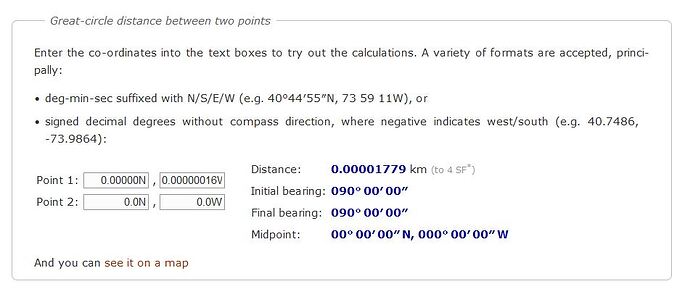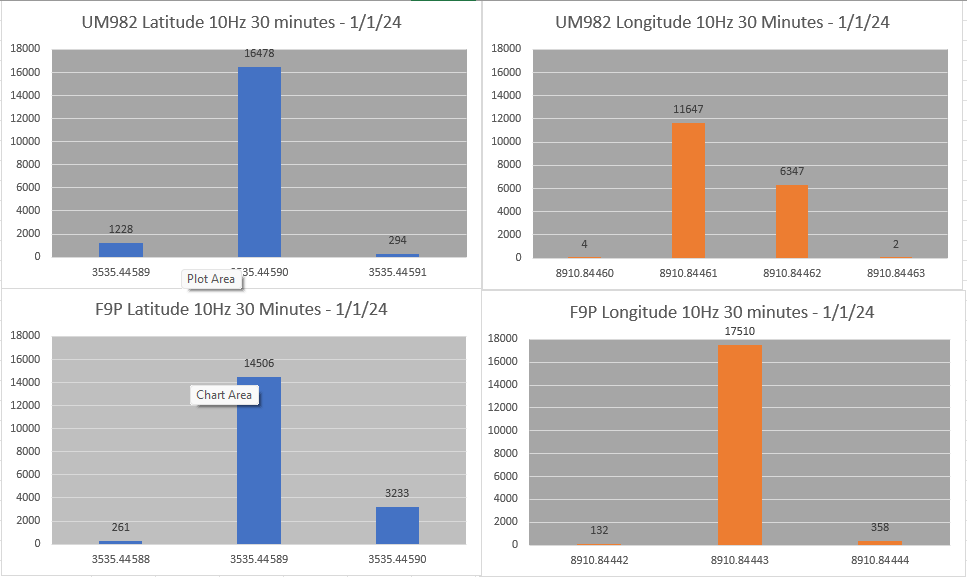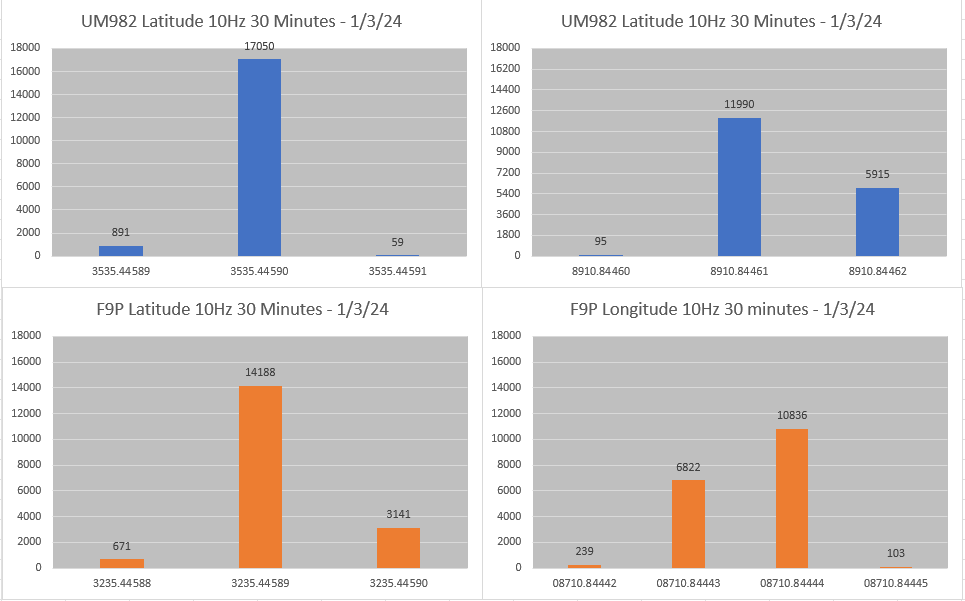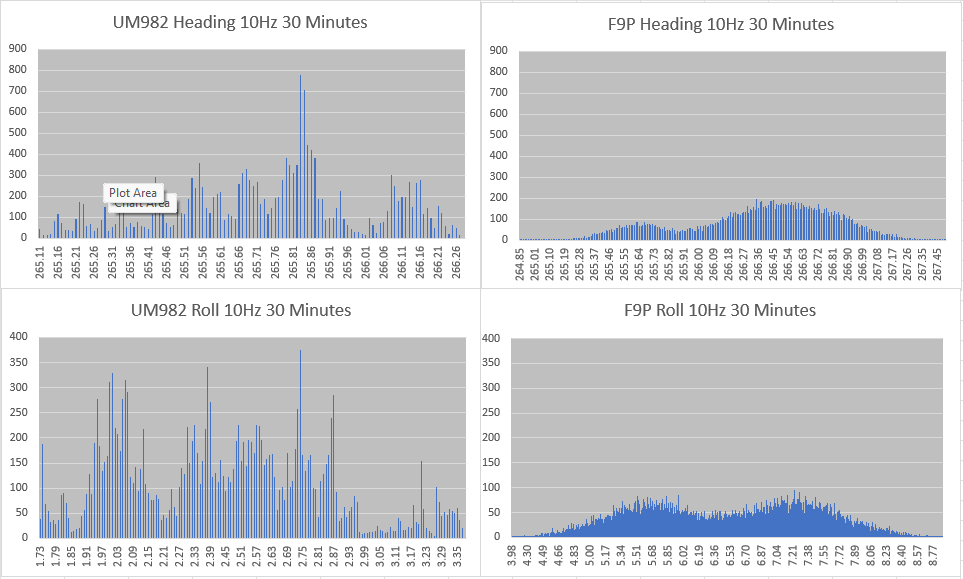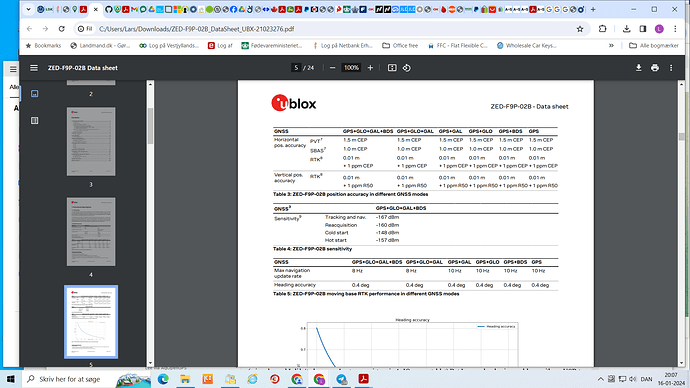I think the higher precision was to help with the Teensy doing calcs internally between the dual receivers but I’m not sure.
@m_elias that is what I saw in the Teensy firmware code. The RelPos routine uses the HP bytes of the RelPosNED message.
I cannot make this match, mostly likely my fault but 1 unit in the degrees/minutes/desimalminutes format at 5 decimal places gives me a distance of 1.8 cm (equator). u-blox talks about cm accuracy and mm accuracy with the high precision mode.
I’d prefer rounding errors below 1 mm. Cannot see any harm from using the high precision mode.
Oh yes I’m off by an order of magnitude.
40075000000 mm / 360 * 0.00001 / 60 = 18.5 mm
Just have to be careful with precision, because more decimal places often is just the illusion of precision. I think the 5 decimal places of minutes, or the 7 decimal places of degrees, adequately describes the maximum precision possible anyway. We can only be as accurate as the least accurate part of the system, and that is the RTK calculation itself. Here I’m speaking only of the representation of the number coming from the GPS unit, not the internal floating point precision AOG itself uses.
My contention is that if you turn on high precision mode on the sentences, you will get more decimal places, and it will appear to be accurate to 1mm or even less, but in reality it won’t be. Even when doing dual GPS you can’t actually get better accuracy even with longer numbers in the sentences. RTK altitude error is around 40 mm anyway.
But I can accept the argument that in the future there will be RTK receivers capable of 1mm or less.
For decimal degrees 8 decimals is 1.11mm, 7 is 11.1mm
F9P max 14mm, um982 8mm accuaracy, so for um982 8 decimals are needed.
From the GIS Wiki. Decimal degrees - GIS Wiki | The GIS Encyclopedia. Eight decimal places is 1.11mm at the equator. From Wikipedia at 45 degrees LAT is it 0.787mm because the Earth is sort of a sphere.
The GGA sentence is using Degrees/Minutes/DecimalMinutes. AgIO converts that to Degrees/DecimalDegrees before sending it to AgGPS.
Thanks all for the discussion and insights!
Once I finish gathering and analyzing the data I will put the results in this thread.
Can someone provide me with a current 4.1 Teensy Hex file that supports KSXT protocols? Thank you very much
Here is an alpha version. This has UM982 support and UDP passthrough turned on. The UM982 will need to configured to send only KSXT sentences. They will be “passthrough” via UDP broadcast. AgIO/AOG laptop will need to be on the same network as the Teensy.
AOB_UM982_UDPPass-Alpha.hex.zip (356.7 KB)
Since you were talking about precision, does anyone know if there is any message in the UM982 that provides Position Accuracy Estimate? Like the HPPOSECEF of the F9P.
I know that there is hdop, pdop etc. but is there anything that estimates it in a metric unit like meter, centimeter or millimeter
It has BESTNAVXYZ for the main antenna and BESTNAVXYZH for the heading antenna. XYZ are in meters with 4 decimal digits. The data can be output in either ASCII or binary. Here is a sample.
#BESTNAVXYZA,87,GPS,FINE,2295,505887000,0,0,18,8;SOL_COMPUTED,NARROW_INT,264572.6374,-5372572.6901,3415824.9204,0.0134,0.0400,0.0205,SOL_COMPUTED,DOPPLER_VELOCITY,-0.0014,-0.0005,-0.0009,0.0296,0.0375,0.0308,“0”,0.000,2.000,0.000,37,33,33,23,0,00,3,f3*13aff66b
The command manual in the very first post in this thread has all the messages and samples for the output data.
Do you mean I could use the fields for Standard deviation of P-X,Y,Z ? So in your example the 0.0134m ,0.0400m ,0.0205m
That is what the manpage says. I have not really delved into the ECEF stuff very much so IDK for sure. There is a parser for the Unicore specific messages in this thread. It is Beta quality code. Based off of the NMEAParser so it operates the same way.
F9P / UM982 testing data and results. For my dual setups, I plan on using the UM982’s as they are less than half the price with no practical difference in performance that I could discern.
Setups:
SimpleRTK2B Lite board with the F9P-02B-00 module - Setup in dual configuration as used by the AOG firmware. Firmware version v1.32. Configs; 1.32 DualAntennaHeading_RelPos.txt and 1.32 DualAntennaPosition_GGA%20VTG%20RTCM.txt from the AOG baords repo. Antennas: ANN-MB-00.
UM982 - Setup dual configuration mode. Antenna: Aliexpress 3-band antenna.
The platform was a metal roof of one of my outbuildings. The RTK base station is an F9P based (dual band) on my property about 40 meters from the GNSS test platform. Both systems were run continuously for 30 days before taking the readings. These charts are the raw GGA readings directly from the GNSS receivers. The UM982 LAT / LON readings have been truncated to 5 decimal places to make them the same level of precision as the F9P readings.
** Edited to make the Y-axis the consistent on the graphs, add raw data files, exact model of F9P tested and info on the base station being a dual band F9P.
Someone also asked about roll and heading stability of the UM982. These readings were taken from the AOG firmware PAOGI output. The firmware was in the AOG boards repo. The F9P is closer to the actual roll of the 6 degree test platform. However, the difference in roll for the UM982 can be compensated for in the AOG firmware.
GNSS Data Analysis_F9P_UM982.zip (1.1 MB)
Interesting results. Your tri-band antenna is quite cheap, I wonder if a more expensive antenna would have improved the UM982 results. On the other hand, the low cost antenna keeps the lower total cost argument valid. Perhaps this tri-band antenna could have been used for some of the F9P tests (showing performance for both with the same antenna).
Can you explain the roll/heading distribution? Why two peaks with the F9P and why UM982 gives a more flat distribution?
I am not sure more expensive = better. The UM982 results look on par with the more expensive F9P. The F9P has been used with successfully AOG for quite sometime.
Part of my motivation was to see if there was a less expensive way to achieve dual GPS for AOG. Perhaps less expensive can bring AOG to even more farmers. The same way AOG itself is bringing autosteering to more farmers by being way less expensive than commercial solutions.
The F9P is a 2 band device so there does not seem to be a way that a 3 band antenna would be utilized. The ANN-MB is made by U-blox and sold as part of packages by Ardusimple. Unicore does not make antennas for their products so there is not a case of using components from the same manufacturer. I could try a like-for-like comparison.
I really can’t explain the “two peaks” phenomenon in the roll data. The sparsity of the UM982 graphs show the UM982 has more readings that are the same. This question does spark the thought of making the Y-axis the same scale. Having been retired for a few years, my Excel Fu has diminished. ![]()

10hz overloads the internal processor and may result in errors. Use a maximum of 5hz.
Edited your post to contain the PDF for F9P heading setup:
chrome-extension://efaidnbmnnnibpcajpcglclefindmkaj/https://content.u-blox.com/sites/default/files/documents/ZED-F9P-MovingBase_AppNote_UBX-19009093.pdf
Wrong link? could not find chapter 2.3.2.
Also reason why many of us prefer firmware 1.13 where 10Hz is fine. But correct for Single 1.32 is supposed to be used, according to the AOG wiki
That is not the datasheet for the module I am using. The Ardusimple boards are using the ZED-F9P-02B. The datasheet for the -02B part shows 10Hz when using 3 constellations GPS+GLO+GAL which is how the AOG config files configure the F9P.
Thanks Chri5k, it is an excellent test.
I see the um982 produces more noise in the heading and roll measurements, do yo know if there is any filter that could smooth them?
Have you tried it in a vehicle to see the impact of those values?
